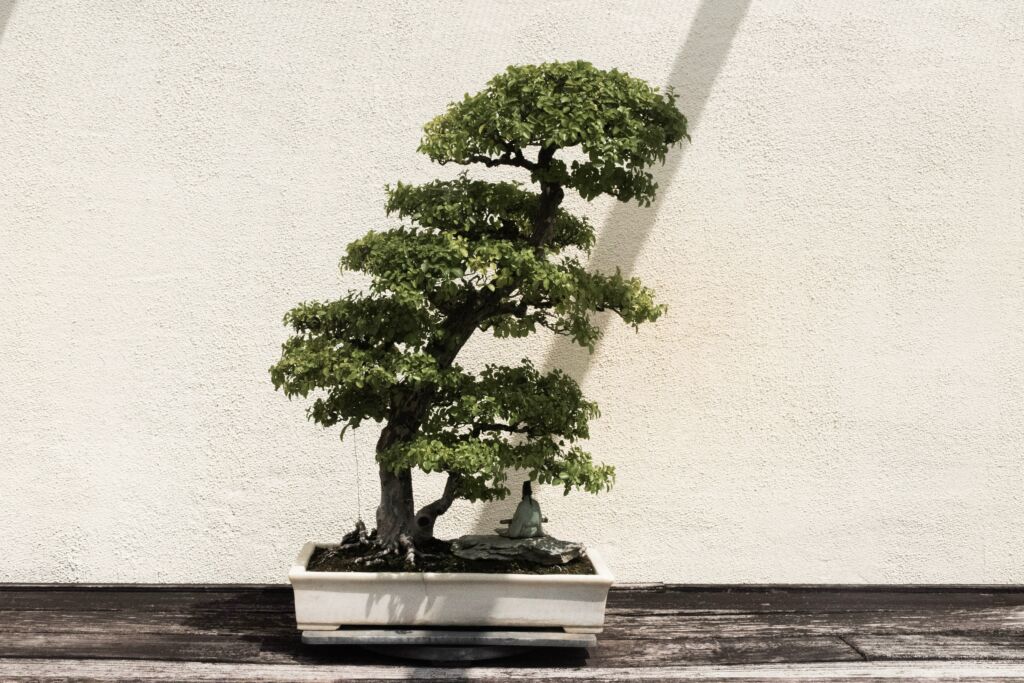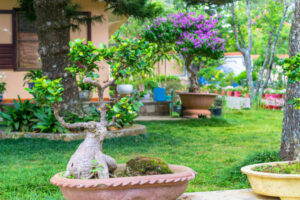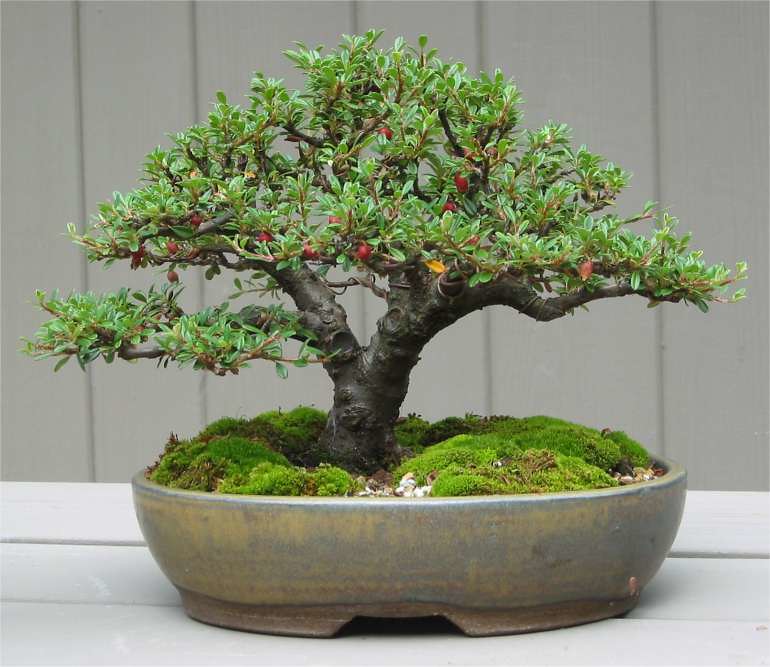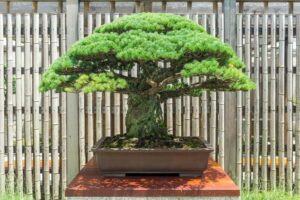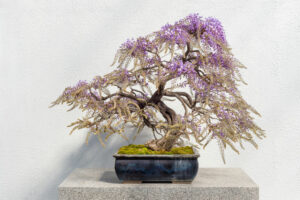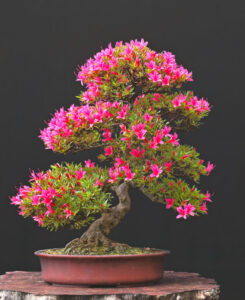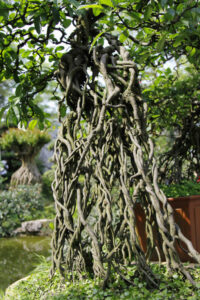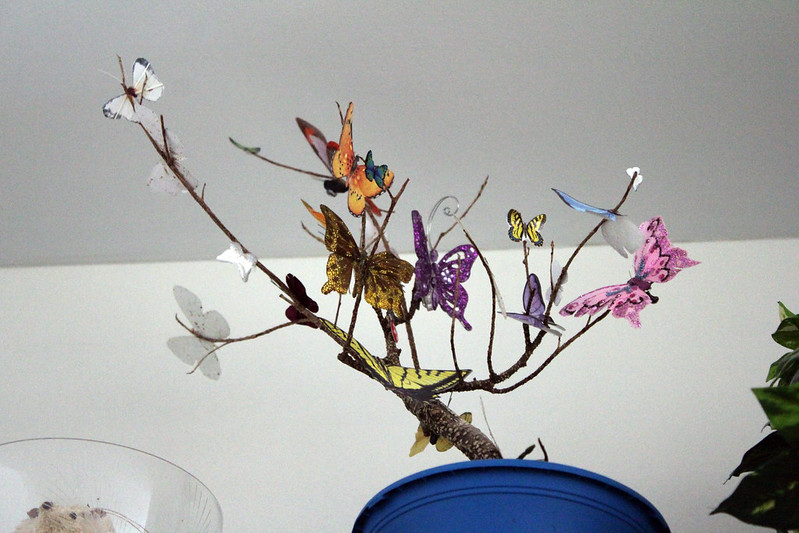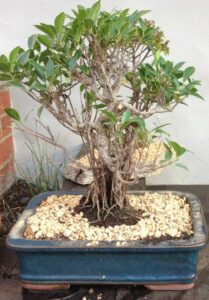HousePlantJoy is supported by our audience. When you purchase through one of our links, we may earn a small affiliate commission. As an Amazon Associate I earn from qualifying purchases. Your cost is not affected.
==================
“Discover the fascinating world of crazy and unusual bonsai trees!”
Bonsai means “tree in a pot.” It is a traditional Asian art form of growing and training methods. It creates small trees in containers that resemble their more giant trees. There are procedures for growing bonsai trees. These are heavy crown trimming, root cutting, and root restriction in shallow pots.
A Beautiful and Unusual Bonsai Tree / Flickr / Windy
Taking care of these seven crazy and unusual bonsai trees is not difficult. They might consider it one of the world’s most calming activities for humans. Bonsai plants are easy to take care of and maintain. It can fit into any environment. Every corner of the world can have it. Everyone can have their own excellent bonsai tree garden.
They are usually put into a small or medium-sized corner in a bonsai pot, so they have minimal space to be placed in your home or office. Unique bonsai trees have natural power that can re-energize the area. So, check out these top 7 crazy and unusual bonsai trees that will make you have them.
Top 7 Crazy and Unusual Bonsai Trees
Human beings are fond of the beauty of different creatures and things. That is why there is no doubt that bonsai trees are popular because of their excellent looks and form. A bonsai is an art form of miniaturizing regular trees and plants.
The Bonsai Art / Flickr / Mike
There are different strange appearances of them. Some artists make the bonsai resemble the usual trees. At the same time, others add things that will make them more astonishing. Here are some of the crazy and unusual bonsai tree species.
1. A Bonsai Tree, now over 390 years old, survived the bombing of Hiroshima
Last August 6, 1945, bonsai master Masaru Yamaki was staying in his home when the bombing happened. A significant force blew out his house’s windows, causing the glass fragments to hit him. Causing him to slash his skin. It has turned out that it was a B-29 bomber from the United States named “Enola Gay.” But not knowing that it was the world’s first atomic bomb dropped on Hiroshima in Japan. It was about two miles away from his house. Since Yamaki is a bonsai artist, he has many of them on the towering wall encircling his outside nursery. So, it helped the bonsai to survive the bombing massacre.
Yamasaki has a collection of 53 bonsais. It includes the now 390-year-old white pine bonsai tree. But the Nippon Bonsai Association gave it to the United States. It was a gift for its bicentennial celebration in 1976.
These types of bonsai trees grow in large pots. Artists trim it to maintain its shape. But despite their artistic freedom, bonsai artists look to nature for inspiration. It is a bonsai-scale reproduction of what they are seeing in nature. Bonsai trees are growing, so they need regular attention. Some people even compare caring for a bonsai tree to caring for a pet.
2. Apple Bonsai Tree: A Crunchy Bliss in Miniature Form
It is beautiful to see your plants with flowers and fruits. So what’s more, if you see your little fruiting bonsai plant on the top of your table, bearing mini apple fruits,
But it is attractive to put them on your office table, coffee table, or anywhere in your bonsai tree garden and your home. So your visitors and friends can see this bonsai tree that is rare of yours. They will be happy to see the cute, unusual piece on your house.
This bonsai is what we call the Apple bonsai tree, also known as the Pitch Apple or Monkey Apply tree. It is a tropical American tree and is native to tropical climates. There are dark green foliage in this plant, and it has aerial roots. It grows into different bonsai designs and blooms pink and white during summer. But the best part is it produces mini apple fruits after the flowers fade.
These kinds of crazy and unusual tiny bonsai trees need a location wherein they can have sunlight. And you can put it indoors or even outdoors. It can endure the cold outside, but protecting the root is a must. So please don’t plant it in shallow bonsai pots. It requires five parts of peat, three parts of argillaceous rocks, and two parts of coarse clay or sand. But Irrigation is essential daily to keep the fruit from withering.
But check it to avoid vine mildew. Do not fertilize it during its fruit-bearing stage because it will cause it not to grow well of fruits. Its fruits are also edible.
3. Wisteria Bonsai Tree: A Whimsical Wonder
Wisteria bonsai trees are flowering bonsai trees. So gardeners who love flowering plants and bonsai choose wisteria bonsai plants. It is a slight variant of the blooming shrub from many countries like China, Japan, and the US.
These weird bonsai trees are a little form of the wisteria trees that grow in bonsai containers. It looks like a crash bonsai but don’t worry, it is not. But wisteria is a shrub that is usually mistaken for a tree. It is because it climbs around the tree’s trunk and swirls around its branches. So it looks like a tree.
The flowers of wisteria bonsai trees make it more attractive. The flowers bloom in blue, lavender, or white. It appears early in the spring and depends on the species.
But it needs a lot of effort and patience if you want to produce its fragrant blossoms. So, knowing first about these flowering tiny bonsai trees is a must before purchasing them. It is notable for sinking and small, close-together petals on the inside. If it is outdoors, the wisteria blossoms bloom in the late spring or early summer. When planted indoors, it can bloom any time of the year. It has a pleasant aroma but not the smell that will overpower you.
4. Azalea Bonsai Tree: Blooms in Miniature
A Beautiful Addition to Your Bonsai Collection
Azalea bonsai trees are mainstream in parts of Europe and different parts. It is part of the Rhodendron family.
It is popular because of its beautiful booms in different shapes, sizes, and patterns. They have small and evergreen plants that are good for bonsai. But its variety is the most popular bonsai, Satsuki, followed by Kurume azaleas. Azalea bonsai trees are deciduous, which means they shed their leaves during fall.
These certain bonsai trees can thrive in the sun. Yet, it must be shielded from rain and sunlight. It is better to make their indoor plants to maintain and ensure the blossoms will last longer.
5. Azuma Makoto Bonsai: A Breathtaking Creation
A Stunning Bonsai Collection / Flickr / Massmatt
Azuma Makoto, a Japanese artist, specializes in complex floral designs. Makoto has even sent a bonsai tree into space. It is part of Makoto’s unconventional methods. To present a vibrant array of different flora. The artist has now revealed a futuristic plant protection machine. 19th-century terrariums inspire it.
The ecosphere, named ‘Paludarium TACHIKO,’ was built for modern society. It is the fourth plant housing unit in the artist’s ongoing series. The machine creates the conditions needed to preserve the plants housed inside it. It serves as an ecosystem within a container. It imitates the conditions required by plants and insects to keep them alive.
But their primary application is either aesthetic, scientific, or horticultural. Built-in fans mimic the breeze, and glass walls let enough natural light get in. There are also waterproof speakers available for listening to music when inside. But these crazy and unusual bonsai trees go through a shortened natural cycle.
6. Bonsai trunk fusion: Fusion Wonders
Trunk fusions are a grafting technique. It uses many methods of grafts of seedlings or rooted cuttings. It is to build a big base trunk with a dramatic, even taper.
The traditional method for growing a trunk is to plant a tree in the ground. Then, the trunk is chopped over several years, even though this method leaves huge scars and a deformed trunk. But trunk fusions are not an ‘old school’ way of growing a Bonsai trunk. And this is not the technique used by the bonsai master John Naka.
The most common method of graft usage is to add a branch to a tree and tie the two together. As the two components expand and enlarge due to the strain fastened together, they fuse into one.
7. Pine Bonsai at Ryokan Yachiyo: Serenity Under the Pines
Pine Bonsai
Ryokan Yachiyo has a black pine bonsai from Kyoto Garden. It took 30 years to grow. Bonsai art necessitates deep knowledge of botanic species. Also, the ability to shape the trunk, clean the roots, prune the leaves, and provide ongoing maintenance. And care to keep it alive. Upkeep is critical.
Pines are very popular in Bonsai cultivation. Many people consider them to be the most common type of Bonsai tree. Pine bonsai trees are evergreen. But they are coniferous viscous or cone-bearing trees. They are with cones and needles appearing in 2 to 5 bundles.
Correct watering, transplanting, and reshaping are essential to bonsais. An example of this is the “third shogun” bonsai. It is in the Saitama Bonsai Art Museum. It took 30 years for their branches to grow 6.5 feet or 2 meters.
8. Flowering Mickey Mouse Bush
Mickey Mouse Bush / Flickr / Michal Chromy
The Flowering Mickey Mouse bonsai tree holds special significance as a symbol of luck during the Vietnamese New Year. Characterized by narrow, oblong to elliptic leaves with shiny green surfaces and finely toothed serrations along the edges, this bonsai variety adds a touch of elegance.
The fragrant yellow flowers transform into vibrant red sepals and eventually produce seeds that undergo a fascinating color transformation from green to black. Intriguingly, when these seeds fall, they often resemble the iconic Disney character “Mickey Mouse.” Beyond its aesthetic charm, this bonsai carries cultural meaning, making it a delightful and auspicious addition to celebrations during the Vietnamese New Year.
9. Butterfly Bush
Butterfly Bush Bonsai / Flickr / Quinn Dombrowski
The Butterfly Bush as a bonsai is like a tiny, beautiful version of the regular bush. It has pretty, sweet-smelling flowers. To take care of it, use soil that lets water pass through, water it just right, and let it enjoy sunlight. Trim it carefully to keep it small and shapely. The Butterfly Bush bonsai is a delightful addition to your plant family. Its charming flowers and nice smell make it special, and since it’s small, it fits well in any space. Taking care of it is easy and brings joy with its tiny beauty.
Best place to grow unusual bonsai trees
Where to Grow Bonsai Trees?
Taking care of the bonsai trees is not as difficult as we thought. The bonsai trees are more intricate than the typical plant. But following a few essential caring guides should allow anyone to care for their tree. Give special attention to where you put it and how you water it.
A Stunning View / Flickr / MICHEL AUBRY
Consider these five main factors when choosing the best place.
- Light: One of the challenging aspects of growing a bonsai indoors is getting sunlight. Your bonsai requires plenty of sunlight to power its processes. It also contributes to the production of small, sensitive bonsai leaves. But, some indoor bonsai need less light than others. But the majority need direct sunlight. A well-lit window is your best choice.
- Humidity: Humidity is excellent for bonsai trees. The perfect place to blossom bonsai trees indoors is anywhere with more moisture in the air. A conservatory or grow room is ideal, but a humidity tray can be enough.
- Temperature: Placing your bonsai near a radiator is a sure way to kill it. Remember, bonsai do not endure concentrated heat. However, avoid placing them on low walls or window frames near a heat source. Unfortunately, your bonsai cannot withstand high temperatures, so remove it from the kitchen.
- Breeze: Pests and dust thrive in stagnant air. It can affect your tree’s potential to photosynthesize. Indoors, the best place for a bonsai to grow is somewhere with good airflow. Put a revolving fan if necessary.
- Protection from Elements: Ensure that the bonsai is shielded from extreme weather conditions such as strong winds, heavy rain, or frost. Protecting from harsh elements helps maintain the health and well-being of the bonsai, preventing damage to delicate branches and foliage.
Wrapping Up: Beautiful Bonsai Trees
A Flowering Bonsai / Flickr / Andreas D.
Having beautiful bonsai trees as a hobby is an ancient living art form. It involves using growing and training techniques. And it creates miniature trees that mimic their larger counterparts. Bonsai has existed around for thousands of years. And its popularity is growing. There is something enticing about learning to shape nature to fit one’s plan and also learning patience and gentleness. Bonsai’s development and cultivation need both patience and talent.
If you would like a bonsai tree to put in your house, you get the Wisteria bonsai tree. It is the bonsai to have, especially if you love flowering plants. It also adds an aroma to your house. But proper care of this bonsai is essential to maintain the fragrance.
FAQs
Is there a bonsai tree that stands out as the coolest that is not on the list of “Top 7 Crazy and Unusual Bonsai Tree Collection”?
The Chinese Elm bonsai is one of the unmentioned yet most astonishing bonsai trees. Known for its elegant and graceful appearance, the Chinese Elm bonsai is highly regarded among bonsai enthusiasts. Its small, glossy leaves and intricate branching patterns make it a popular choice for bonsai cultivation. The Chinese Elm bonsai also exhibits excellent adaptability, making it suitable for various environments and skill levels.
Do jade bonsai trees fit the article?
Yes, the article can include the jade bonsai trees. Jade plants (Crassula ovata) are known for their thick, fleshy leaves and unique appearance. While not as commonly seen as other bonsai varieties, jade bonsai trees can be a captivating addition to any collection. With proper care and maintenance, jade bonsai trees can thrive and develop an intricate trunk structure and vibrant green foliage.
Do pine trees make it to the list of the top unusual bonsai trees in the article?
While the specific article on the top unusual bonsai trees might not include pine trees, they are a classic and widely appreciated choice in the world of bonsai. Pine bonsai trees are revered for their timeless beauty and ability to evoke a sense of tranquility. Pine bonsai trees exude a sense of strength and resilience with their characteristic needle-like foliage and rugged bark. These trees require specialized care, including proper pruning techniques and soil composition, to maintain their unique characteristics in a bonsai form.
What are the other types of bonsai trees?
Japanese Maple Bonsai: A famous outdoor bonsai tree, the Japanese Maple is known for its stunning foliage and beautiful fall colors.
Juniper Bonsai Tree: An easy-to-care-for outdoor bonsai tree, Juniper bonsai trees come in many varieties and are known for their hardiness and resilience. It is also one of the most expensive bonsai trees; a Sargent Juniper tree could sell at $350,000.
Ficus: A popular indoor and one of the most expensive bonsai trees, Ficus Bonsai trees come in many varieties and are known for their air-purifying abilities and ease of care.
Elm: An outdoor bonsai tree, Elms are known for their graceful, sweeping branches and delicate leaves.
Chinese Elm: A famous outdoor bonsai tree, Chinese Elms are known for their hardiness and ability to adapt to different environments.
Serissa: An indoor bonsai tree, Serissa is known for its beautiful white, pink, or red blooms and small, delicate leaves.
Is the Brazilian raintree a deciduous hardwood tree?
No, the Brazilian rain tree is not deciduous; it is an evergreen tree, retaining its leaves throughout the year. Native to the rainforests of Brazil, it thrives in environments with abundant sunlight and water, which contributes to its year-round green appearance.
The Brazilian raintree falls into the category of hardwood trees, known for their robust and durable wood. This wood is commonly utilized in furniture making, construction, and boat construction. In its natural habitat, this tree can reach heights of up to 100 feet, but when cultivated as a bonsai tree, it typically remains much smaller.
Where can I find unique bonsai trees for sale?
Finding unique bonsai trees for sale can be an exciting journey, and there are various avenues you can explore. Here are some suggestions:
- Local Nurseries and Garden Centers
- Specialized Bonsai Nurseries
- Bonsai Shows and Exhibitions
- Online Bonsai Retailers
- Bonsai Clubs and Forums
- Bonsai Auctions
- Private Sellers and Artists
- Botanical Gardens
- Japanese Gardens
Remember to do thorough research on the care requirements of any bonsai species you are interested in, especially if it’s a unique or rare variety. Additionally, ensure that you’re purchasing from reputable sources to guarantee the health and authenticity of the bonsai tree.
Does a bonsai tree bring fortune?
In Feng Shui, an ancient Chinese practice about creating good energy, bonsai trees are like good luck charms. People believe that a bonsai tree, called “chi,” brings positive energy and helps make everything balanced. Putting a bonsai in certain parts of your home or workplace is thought to bring good luck, wealth, and prosperity. Bonsai trees are small and need careful attention, showing patience and balance, which are essential in Feng Shui. So, having a bonsai around is like inviting good vibes into your space. It’s a way to make things feel cheerful and lucky, creating a happy and prosperous atmosphere.
What are some examples of bonsai tree species commonly used in cultivation?
Some common bonsai tree species include juniper, pine, maple, and ficus. People often grow and take care of these kinds of bonsai tree species.
Is there such a thing as a petite bonsai tree?
A petite bonsai tree is a smaller version of a regular bonsai, famous for its compact size and delicate appearance. It requires special care to maintain its miniature form. A popular petite bonsai collection includes the Fukien tea tree and the shohin bonsai varieties, known for their charming small stature. Cultivating bonsai plants requires attention to detail and precision to achieve and sustain their small size.
Read More
Bonsai Garden: A Full Guide to Create It
Bonsai Tree: Ultimate Care Guide
Simple Bonsai Guide for Beginners
The Meaning and Uses of the Bonsai Tree in Feng Shui

